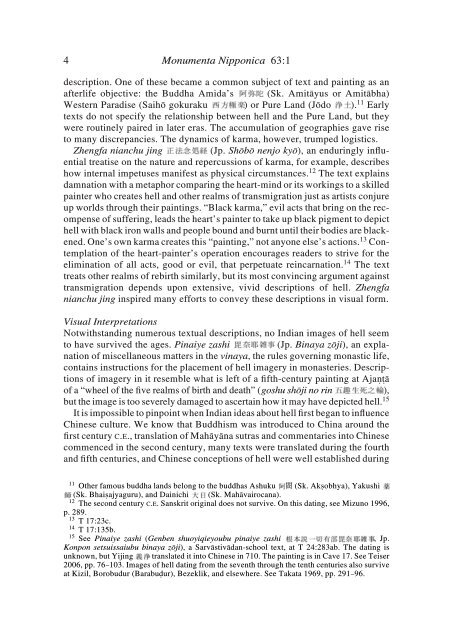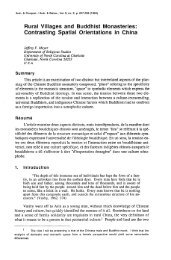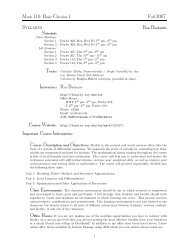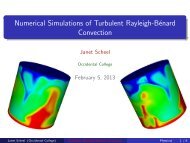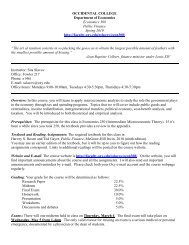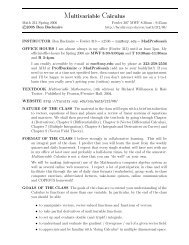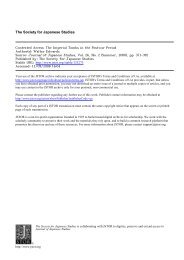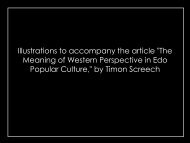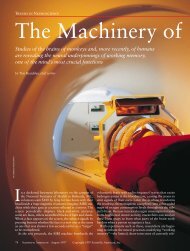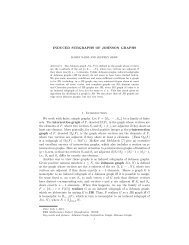A Primer on Japanese Hell Imagery and Imagination - Occidental ...
A Primer on Japanese Hell Imagery and Imagination - Occidental ...
A Primer on Japanese Hell Imagery and Imagination - Occidental ...
Create successful ePaper yourself
Turn your PDF publications into a flip-book with our unique Google optimized e-Paper software.
4<br />
M<strong>on</strong>umenta Nipp<strong>on</strong>ica 63:1<br />
descripti<strong>on</strong>. One of these became a comm<strong>on</strong> subject of text <strong>and</strong> painting as an<br />
afterlife objective: the Buddha Amida’s (Sk. Amitâyus or Amitâbha)<br />
Western Paradise (Saihô gokuraku ) or Pure L<strong>and</strong> (Jôdo ). 11 Early<br />
texts do not specify the relati<strong>on</strong>ship between hell <strong>and</strong> the Pure L<strong>and</strong>, but they<br />
were routinely paired in later eras. The accumulati<strong>on</strong> of geographies gave rise<br />
to many discrepancies. The dynamics of karma, however, trumped logistics.<br />
Zhengfa nianchu jing (Jp. Shôbô nenjo kyô), an enduringly influential<br />
treatise <strong>on</strong> the nature <strong>and</strong> repercussi<strong>on</strong>s of karma, for example, describes<br />
how internal impetuses manifest as physical circumstances. 12 The text explains<br />
damnati<strong>on</strong> with a metaphor comparing the heart-mind or its workings to a skilled<br />
painter who creates hell <strong>and</strong> other realms of transmigrati<strong>on</strong> just as artists c<strong>on</strong>jure<br />
up worlds through their paintings. “Black karma,” evil acts that bring <strong>on</strong> the recompense<br />
of suffering, leads the heart’s painter to take up black pigment to depict<br />
hell with black ir<strong>on</strong> walls <strong>and</strong> people bound <strong>and</strong> burnt until their bodies are blackened.<br />
One’s own karma creates this “painting,” not any<strong>on</strong>e else’s acti<strong>on</strong>s. 13 C<strong>on</strong>templati<strong>on</strong><br />
of the heart-painter’s operati<strong>on</strong> encourages readers to strive for the<br />
eliminati<strong>on</strong> of all acts, good or evil, that perpetuate reincarnati<strong>on</strong>. 14 The text<br />
treats other realms of rebirth similarly, but its most c<strong>on</strong>vincing argument against<br />
transmigrati<strong>on</strong> depends up<strong>on</strong> extensive, vivid descripti<strong>on</strong>s of hell. Zhengfa<br />
nianchu jing inspired many efforts to c<strong>on</strong>vey these descripti<strong>on</strong>s in visual form.<br />
Visual Interpretati<strong>on</strong>s<br />
Notwithst<strong>and</strong>ing numerous textual descripti<strong>on</strong>s, no Indian images of hell seem<br />
to have survived the ages. Pinaiye zashi (Jp. Binaya zôji), an explanati<strong>on</strong><br />
of miscellaneous matters in the vinaya, the rules governing m<strong>on</strong>astic life,<br />
c<strong>on</strong>tains instructi<strong>on</strong>s for the placement of hell imagery in m<strong>on</strong>asteries. Descripti<strong>on</strong>s<br />
of imagery in it resemble what is left of a fifth-century painting at Ajaṅṫâ<br />
of a “wheel of the five realms of birth <strong>and</strong> death” (goshu shôji no rin ),<br />
but the image is too severely damaged to ascertain how it may have depicted hell. 15<br />
It is impossible to pinpoint when Indian ideas about hell first began to influence<br />
Chinese culture. We know that Buddhism was introduced to China around the<br />
first century C.E., translati<strong>on</strong> of Mahâyâna sutras <strong>and</strong> commentaries into Chinese<br />
commenced in the sec<strong>on</strong>d century, many texts were translated during the fourth<br />
<strong>and</strong> fifth centuries, <strong>and</strong> Chinese c<strong>on</strong>cepti<strong>on</strong>s of hell were well established during<br />
11 Other famous buddha l<strong>and</strong>s bel<strong>on</strong>g to the buddhas Ashuku (Sk. Akṡobhya), Yakushi<br />
(Sk. Bhaiṡajyaguru), <strong>and</strong> Dainichi (Sk. Mahâvairocana).<br />
12 The sec<strong>on</strong>d century C.E. Sanskrit original does not survive. On this dating, see Mizuno 1996,<br />
p. 289.<br />
13 T 17:23c.<br />
14 T 17:135b.<br />
15 See Pinaiye zashi (Genben shuoyiqieyoubu pinaiye zashi , Jp.<br />
K<strong>on</strong>p<strong>on</strong> setsuissaiubu binaya zôji), a Sarvâstivâdan-school text, at T 24:283ab. The dating is<br />
unknown, but Yijing translated it into Chinese in 710. The painting is in Cave 17. See Teiser<br />
2006, pp. 76–103. Images of hell dating from the seventh through the tenth centuries also survive<br />
at Kizil, Borobudur (Barabuḋur), Bezeklik, <strong>and</strong> elsewhere. See Takata 1969, pp. 291–96.


